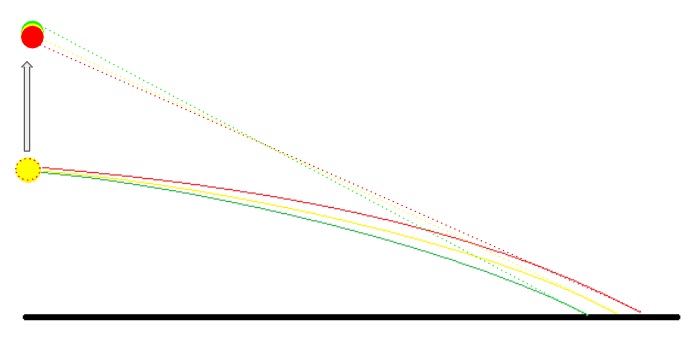Maybe this will help. These are exaggerated to better show how the refracting of different wavelengths works to create the dispersion of color.
In this example, light is bending toward earth as it encounters increasing air density, refracting towards the denser medium. Red (longer wavelength) is refracted less than green (shorter wavelength). Because the green light has experienced a greater degree of refraction, the perceived elevation of that source will be higher than the less-refracted red. So the green rim will be elevated above the longer wavelength colors.

That prism-effect of refraction isn't enough to produce a perceptible green rim on the sun except under fine detail in some photographs. But that isn't the "flash." To get the flash you need the magnification of that thin green rim by a mirage or mock mirage. Even then, it often takes a camera with telephoto to capture it. I've never seen it with my naked eyes.
But that's the explanation. And as long as sunlight is passing through the atmosphere/layer at an angle where it is encountering increasing density, it will refract toward the normal; toward the denser medium. In an atmosphere, conforming around a spherical earth, that happens even if the light is tangent to the earth. Because the atmosphere curves away, the light will refract to try to follow the lower, denser portion of the atmosphere. On a flat earth, that won't happen (unless there's some principle of atmolayer layering over a flat earth that isn't also flat.)
But regardless, if penetrating the atmolayer at an angle, this will happen on a flat earth also. You just need the geometry to produce a shallow enough angle.
In either case, that type of refraction (toward the earth) will also push the sun to appear higher, not lower. On a globe, it's said the sun at sunset is a whole width higher than it is astronomically due to this atmospheric refractive effect. That means when you see the sun touch down on an sea horizon, its geometric position is actually completely below the horizon. It is this same rationale for why globe earth curvature calculators must take into consideration standard atmospheric refraction and not rely on mere geometric calculation. Light refracts to follow the curve, making things appear above the horizon that might otherwise be obscured were it not for the atmosphere.
Now, as for refraction in the opposite direction:

Without explaining how it works, "refraction" has been cited by FE proponents to explain how a sun that is actually remaining overhead but receding into the distance over a flat earth can appear to descend to the horizon. In order for that to be true, the light from the sun must curve away from the flat surface of earth. If it's actually refraction doing that, then that means the upper layers of the atmolayer must be denser than the lower elevations. That may be true in isolated, transient and non-standard conditions but isn't typical; certainly not standard enough to consistently produce a setting sun day in and day out.
Additionally, even if one claims that the atmolayer actually is causing light to bend upward, remember that the prism effect would cause greens to refract more and reds less, but because the direction is reversed, so is the fringing on the sun and the green rim would be on the bottom of the setting sun, not the top.
The same reasoning applies regardless of what's causing the bending. If it's EAT, then EAT will affect the shorter wavelengths slightly more than the longer wavelengths and produce a bottom-limb green fringe too vice the upper-limb "green flash" we can observe.
(Edit: thinking on this a bit, I realize now that EAT makes no such commitment. Just because refractive "bending" affects shorter wavelengths more than longer wavelengths doesn't mean that that is necessarily true if EA is doing the bending. There's a reason why it is true of refraction in optics, but given that EA is based on dark energy concepts and has -- for 10 years now -- remained an untested and still developmental hypothesis, I suppose that assuming that the "bendy" influence would have a dispersive effect similar to refraction might not be a sound one. It might help to know how the equation was derived to know if there's any wavelength, frequency or energy dependency on the amount of x-y "bending." This is just occurring to me.)My argument is that this is one of the ways to zetetically determine whether or not EAT (or upward refraction) is causing the sun to appear to set; unless, of course, there is some other explanation for the prismatic effect on the sun that hasn't been discovered yet. But it can't be the same as the explanation used in a globe earth without undermining any light-bending-upwards explanations to explain how the sun can appear lower than it actually is.